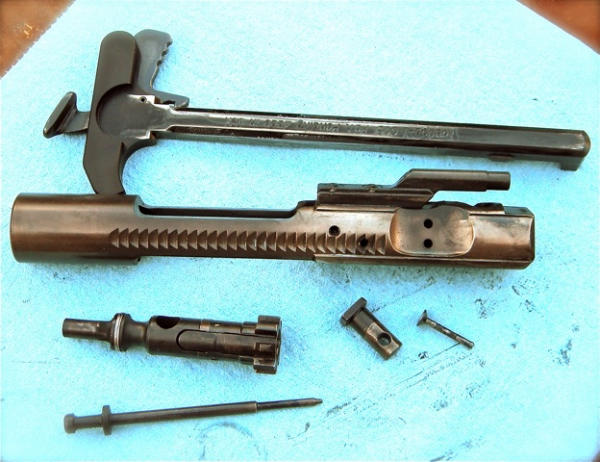
The AR is like an internal combustion engine. There’s a lot of friction – and associated heat and wear – that occurs during a shot. Even more so when firing multiple rounds. The key to having a smooth running, reliable AR is lubrication.
Compared to most rifles and carbines the AR doesn’t have a lot of friction surfaces, but what there are must be lubricated well. There’s aluminum on aluminum contact – a recipe for disaster if not well lubed. Aluminum parts are moving against steel, and there’s steel on steel contact. Without lubrication any of these combinations will start galling, creating more friction and wear, and eventually lock up tight, probably never functioning again.
Most people think the AR is a finicky weapon. “Oh,” they say, “it won’t run when it gets dirty.” So they focus on constantly cleaning the AR, with very little thought given to lubrication. The truth is the AR will run, and run reliably even when it’s filthy. Shootrite Katana #1, built by MHT Defense, has well over twenty thousand rounds through it without ever having been cleaned, or any parts replaced. It has been well lubed the whole time. With ARs lubrication is more of a concern than cleaning. I’m not saying you should run thousands of rounds through it without a cleaning, but I have to admit I clean mine when I think it needs it vs. every time it’s fielded and fired.
To lube the AR we teach using a combination of oil – Slip 2000 EWL – and grease – TW25B. Oil is a great lube, but over time will wick with gravity and start to dry up. Grease is good, but will start to gum up. When using them together each one offsets the other’s deficiency. First you put down a layer of TW25B, working it into the pores of the metal. Then put a layer of oil over the grease. The grease keeps the oil from migrating due to gravity, and the oil prevents the grease from getting caked up. Lubing with these two products works really well.
The primary points to lube are the bolt carrier, bolt, charging handle and buffer spring. All these parts see a lot of friction, heat and wear. If you look at these parts, for example in the picture above, you’ll actually see the areas that are worn from the contact and friction. The shoulders or rails on the bolt carrier and the gas key and bottom where it resets the hammer need to be well lubed. The bolt has a shoulder in the middle, plus the gas rings and lugs of the bolt, which mate up with the barrel extension. Be sure to put some oil on the extractor and ejector. The charging handle sees a lot of use; lube it with grease and oil on top. The buffer spring is a large friction area - I normally just use oil on it. The trigger group needs very light lubrication, and only at exact point of contact.
As you clean and lube, inspect all small parts for wear. Keep your AR maintained and lubed well and it will serve you for many years, whether you’re burning lots of ammo during training and practice, or it’s resting in storage or transport, waiting for the time it’s needed.
Tiger McKee is director of Shootrite Firearms Academy, located in northern Alabama. He is the author of The Book of Two Guns, AR-15 Skills and Drills, featured on GunTalk’s DVD, “Fighting With The 1911 and has regular columns in Gun Digest and American Handgunner.
http://www.facebook.com/pages/Shootrite-Firearms-Academy/156608611038230?ref=ts